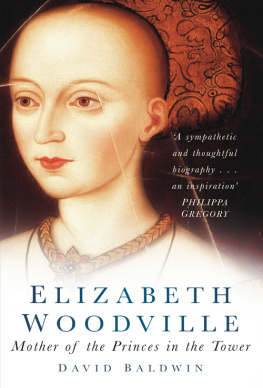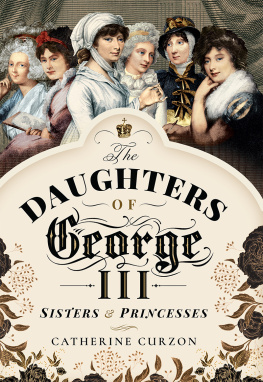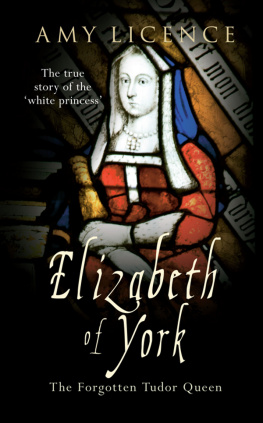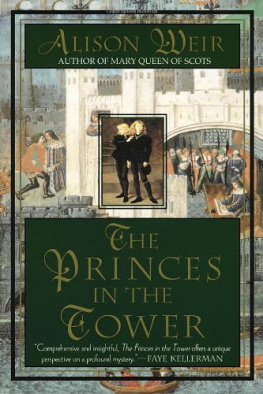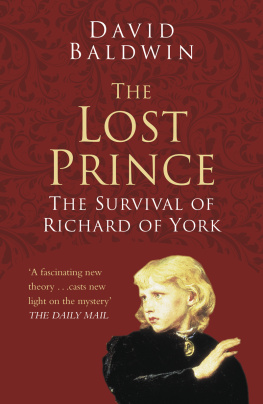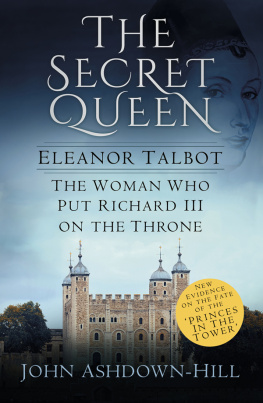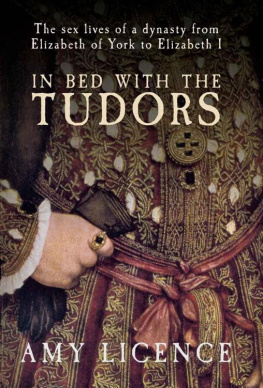Contents
Guide

The York Princesses
The daughters of Edward IV and Elizabeth Woodville
Also by Sarah J Hodder
The Queens Sisters The Lives of the Sisters of Elizabeth Woodville

JOHN HUNT PUBLISHING
First published by Chronos Books, 2021
Chronos Books is an imprint of John Hunt Publishing Ltd., No. 3 East St., Alresford, Hampshire SO24 9EE, UK
www.johnhuntpublishing.com
www.chronosbooks.com
For distributor details and how to order please visit the Ordering section on our website.
Sarah J. Hodder 2020
ISBN: 978 1 78904 557 4
978 1 78904 558 1 (ebook)
Library of Congress Control Number: 2020933341
All rights reserved. Except for brief quotations in critical articles or reviews, no part of this book may be reproduced in any manner without prior written permission from the publishers.
The rights of Sarah J. Hodder as author have been asserted in accordance with the Copyright, Designs and Patents Act 1988.
A CIP catalogue record for this book is available from the British Library.
Design: Stuart Davies
UK: Printed and bound by CPI Group (UK) Ltd, Croydon, CR0 4YY
Printed in North America by CPI GPS partners
We operate a distinctive and ethical publishing philosophy in all areas of our business, from our global network of authors to production and worldwide distribution.
The marriage of King Edward IV to Elizabeth Woodville was highly controversial even from its humble beginnings in a hermitage in the sleepy Northamptonshire village of Grafton Regis. A beautiful widow with two young sons, Elizabeth was considered a commoner, and a highly unsuitable match for the Yorkist King. She and her Woodville relations were unpopular with many of the great and noble families in the country who resented their steep and sudden ascent to power that resulted from her marriage. Labelled upstarts and social climbers, it is a reputation that is still attributed to them even today. Her father, Richard Woodville, was a mere soldier who had served in France under the Duke of Bedford. The fact that through her mothers side she was descended from one of the most distinguished families in Luxembourg, the Counts of Saint Pol, and that her mother, Jacquetta, had once been married to the very same Duke of Bedford that her second husband had served, making her, at one point, one of the highest ranking Ladies in England, was overlooked by those wishing to disparage her.
On 1 st May 1464, Elizabeth Woodville made what many deemed a fortuitous marriage to the Yorkist King of England, Edward IV, although for Elizabeth and Edward it was simply a love match. They made their vows in secret, at her home, with only Elizabeths mother taken into their confidence. The marriage was not revealed publicly for almost four months, until during a council meeting at Reading in September that year, Edward had been questioned on his choice of future bride and had revealed that the discussions were unnecessary, he was in fact already married. In later years it would be said that Elizabeth had enchanted him into marrying her and she would be accused, albeit not formally, of witchcraft. Her mother would also have to officially defend herself against accusations of sorcery and enchantment.
But despite their detractors, Edward and Elizabeth were married for eighteen years. Having only ascended to the throne himself in 1461, deposing the old King, Henry VI, by defeating him and the Lancastrian army on the battlefield at Towton, Elizabeth was by his side for the majority of his twenty-one-year reign.
During their marriage they had ten children together. Three of these were boys of whom one, George Duke of Bedford, did not survive past the age of two, dying in 1479. Their other two sons, Edward, Prince of Wales, and Richard, Duke of York, would grow up and become known to history as the ill-fated Princes in the Tower. Their story is still one of the great unsolved mysteries; their disappearance from the Tower where they were housed after the death of their father whilst awaiting Edwards coronation as Edward V, remains unexplained to this day. The usurpation of the throne by their uncle Richard, Duke of Gloucester, who went on to become Richard III, led many of his contemporaries and historians across the subsequent centuries to suspect that he had a hand in their disappearance. No definitive proof survives of his involvement and convincing arguments have been made asserting his innocence and apportioning the blame in the direction of others, including Elizabeths brother-in-law and close associate of Richard, the Duke of Buckingham, and Margaret Beaufort, the mother of the future King Henry VII. Pretenders at the later Tudor Court would insist they were the lost Princes, with one of them, known to history as Perkin Warbeck, presenting a highly convincing case that perhaps one of the two Princes of York did manage to escape their imprisonment. The fate of the two boys may now never truly be discovered, although bones found in 1674 by workmen at the Tower of London, digging below the stairs that led from the Royal Apartments to the White Tower are purported to belong to two young boys. The bones were reburied in Westminster Abbey by Charles II. Further DNA testing has not yet been allowed and may never be.
As well as George, Richard and Edward, the King and Queen were also parents to seven girls. It wouldnt be unmerited to say that most of the York Princesses fared better in their lives than their unfortunate brothers did, although Thomas More writing in his history of Richard III laments that the division and dissension of their friends had unarmed them and left them destitute. Certainly, during their early years, all the royal siblings led a charmed existence, adored by their parents and safely ensconced within court life. Three of the oldest girls, Elizabeth, Mary and Cecily, had been born and would have been caught up in the tumultuous period of 1470-71, when their father was forced to flee abroad, and their mother took sanctuary in Westminster Abbey, fearing for her life, but at this point the girls would have been only four, three and one year respectively, so it is likely that only the eldest Elizabeth, if any, would have had memories of this time.
Describing Christmas at court in 1482, the writer of the Croyland Chronicle remarks that the royal court presented an appearance that fully befits a most mighty kingdom, filled with riches and boasting of those sweet and beautiful children, the issue of his marriage with Queen Elizabeth. Certainly, the young princesses and their brothers at this point in their childhood would have been thriving, feeling safe and secure within the royal family and sure of their destinies. For Edward Prince of Wales, he was being raised as the future King of England, his brother Richard his loyal supporter, who would perhaps follow in the footsteps of his uncle, Richard, and become a powerful magnate in the north, assisting Edward in ruling the Kingdom. For the young princesses, their future was not to rule England, but to attain suitable marriages, ideally to Princes of other Kingdoms where they would rule alongside their husbands or at the very least to one of the noble men of the realm.
But then in 1483 fortunes wheel turned, as it is liable to do, and in April of that year the sudden and unexpected death of their father ended life as they knew it. What should have inevitably been a sad occasion followed by a time of celebration as their elder brother rightly took his place on the throne of England, turned into what could arguably be described as the worst moments of their young lives. Under threat from their uncle, Richard, and with their family thrown into turmoil, they were forced to flee into sanctuary with their mother the second time Elizabeth Woodville had had to run with her children into the safety of Westminster Abbey.



